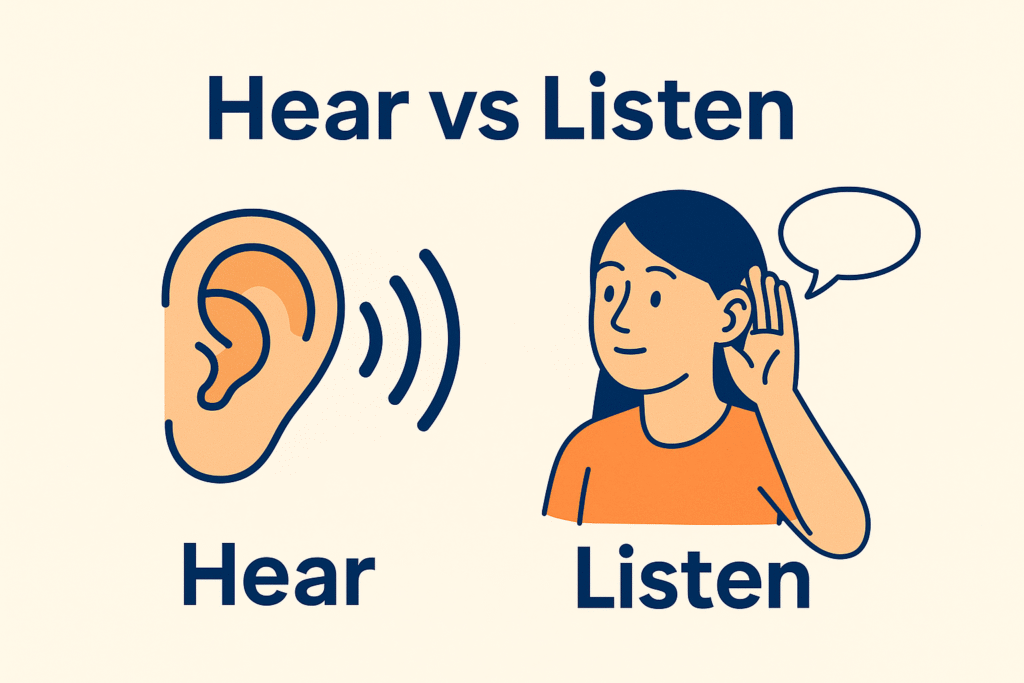Hear vs Listen

You may think “hear” vs “listen” mean the same thing but they don’t. These two verbs are closely related because both involve using your ears, but they represent different actions. Mixing them up in conversation or writing can make your communication sound unnatural or imprecise, especially in professional or academic settings.
Hear refers to the passive act of perceiving sound.
Listen refers to the active act of paying attention to sound.
Understanding this difference can improve not only your grammar but also your communication skills. In this article, we’ll dive into the grammatical structure, explore real-life examples, point out common mistakes, and provide simple tips to help you remember the distinction between hear and listen.
Grammatical Explanation
Let’s take a closer look at the grammar:
- Hear is usually an involuntary action you don’t try to hear; it just happens.
It’s commonly used without a preposition.- Example: I hear birds outside the window.
- Listen is an intentional action you focus your attention to interpret the sound.
It is usually followed by “to.”- Example: I’m listening to a podcast.
Tense Forms:
| Verb | Past Tense | Present Participle | Example Sentence |
|---|---|---|---|
| Hear | Heard | Hearing | I heard a strange noise. |
| Listen | Listened | Listening | She was listening to music. |
While hear is about sound entering your ears, listen involves the brain actively processing that sound.
Real-Life Examples
Here’s how hear vs listen look in real-life use:
✅ Hear (Passive Perception):
- I heard the door slam.
- Did you hear the thunder last night?
- He can’t hear very well without his hearing aid.
✅ Listen (Active Attention):
- She’s listening to her favorite band.
- Please listen carefully to the instructions.
- The children listened to the story with wide eyes.
❌ Incorrect Usage:
- I was listening a strange noise. ❌
✅ I was hearing a strange noise. (or better: I heard a strange noise) - He heard to the radio. ❌
✅ He listened to the radio.
Quick tip: If you are giving focus or attention, choose listen. If it just happens, use hear.
Common Mistakes found in Hear vs Listen
One of the most common errors is using hear when you mean listen, and vice versa. Here are some typical mix-ups:
❌ I was listening something outside.
✅ I was listening to something outside.
❌ Can you hear to this track?
✅ Can you listen to this track?
Another common mistake is thinking “hear” means understanding. It doesn’t.
❌ I hear what you mean. (when you mean you understand)
✅ I see what you mean. or I get your point.
Make sure to use hear for physical sound perception and listen when focusing attention.
Memory Tips for Hear vs Listen
How do you remember the difference between hear and listen?
- Hear is automatic like breathing.
You don’t need to try. - Listen requires effort like reading.
You have to focus.
Mnemonic:
“You hear with your ears. You listen with your mind.”
Another trick:
- Think of “listen” as having the word “silent” inside it because you usually need silence to listen carefully.
You can also picture these two scenarios:
- You’re walking and hear a dog barking = you didn’t try.
- You stop walking to listen to where the sound is coming from = you’re paying attention.
→ Want to master more tricky pairs? Check out our post on Too vs To
→ For more examples and exercises, visit Cambridge Dictionary – Hear vs Listen
Conclusion
The difference between hear and listen lies in attention. Use hear when describing passive sound perception. Use listen when you’re focusing on sounds or trying to understand them.
Want to sound more fluent in English? Knowing when to use hear vs listen will take your communication skills to the next level.